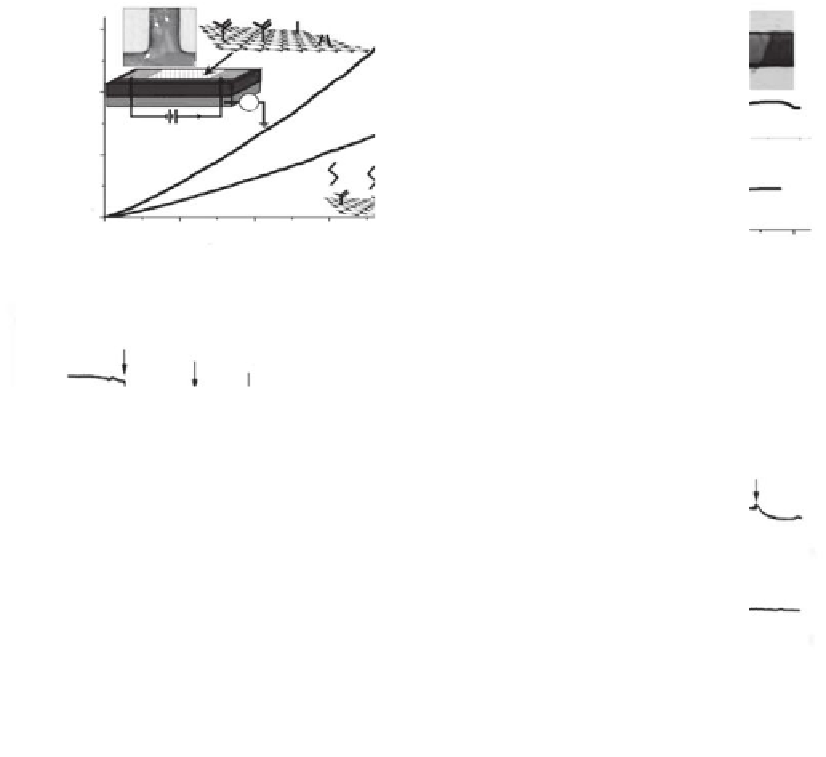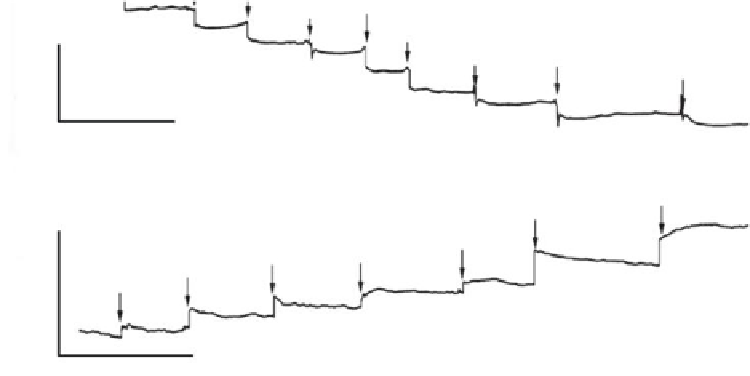Environmental Engineering Reference
In-Depth Information
-
O
O
-
O
-
OOH
1
2
1.5
-
O
1E-5
GO
1.9
GO
SiO2
1E-6
1.0
Silica
Silicon
V
G
1E-7
1E-8
I
DS
GA gating
V
DS
1.8
-100
0 100
Voltage,
V
c
(V)
0.5
NH
+
NH
-
O
NH
O
NH
GA
1.7
0.0
V
DS
= 8 V
GO gating
4
Voltage (V)
8
0
2
6
(a)
(b)
-200
-100
0
100
200
Voltage,
V
G
(V)
1 µM
3 µM
(c)
6 µM
15 µM
21 µM
10 µM
28 µM
36 µM
45 µM
55 µM
100 s
28 nM
21 nM
(d)
15 nM
6 nM
10 nM
3 nM
1 nM
50 s
FIGURE 34.4
(a) Current-voltage behavior of the GO and graphene-amine (GA) devices with GA device showing lower con-
ductivity than the parent GO. The insets show the schematics of GO/GA devices and their chemical structure.
(b) Electrical gating studies of GO and amine-GO showing the p-type semiconductor behavior. (From Mohanty,
N. and Berry, V.,
Nano Lett
.,
8, 4469, 2008. With permission.) Typical real-time recording of
I
DS
from the patterned
RGO FETs with the addition of Ca
2+
ions (c) and Hg
2+
ions (d). (Adapted from Sudibya, H. G. et al
.
,
ACS Nano
,
5,
1990, 2011. With permission.)
Sudibya et al.
171
used chemically functionalized RGO micropatterns to construct FETs
for the speciic detection of heavy metal ions (Figure 34.4d and e). First, metallothionein
type II (MT-II), which can bind to heavy metal ions with high afinity and selectivity,
was anchored on to patterned RGO channels using speciic linkers. The sensor could
selectively detect ultralow concentrations of Hg
2+
(detection limit 1 nM or 0.2 ppb) in the
presence of other ions such as Mg
2+
, Ca
2+
, or K
+
. Similarly, using calmodulin (Ca
2+
bind-
ing protein) instead of MT-II, selective detection of Ca
2+
was possible. It was reported
that the conformational change of the functionalized protein upon metal binding is
the cause for the electrical changes. The negatively charged protein came closer to the
graphene channel owing to the conformational changes resulting in a stronger gating
effect.
171




